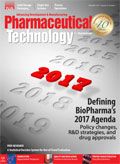Bio/Pharma’s 2017 Agenda
Healthcare policies, R&D investments, and drug approvals will test bio/pharma.
Illustration by Dan Ward

For an industry that relies on the stability of its products for patient safety and company success, the outlook for the bio/pharma industry itself--as well as the healthcare system, patient access to affordable medicines, speedy drug approvals, and global regulatory compliance--had a large dose of uncertainty as the calendar turned to 2017.
The election of populist candidate Donald Trump as president of the United States shocked many and created unease in the public and private sectors, but it also boosted the financial outlook for bio/pharma companies, at least in the short term. The investment community viewed the Trump administration as more pharma-friendly compared to the stated positions of the Clinton administration to rein in drug costs. Bio/pharma stocks rallied after Election Day. Analysts noted a “sunny” weather forecast for the pharma and biotech sector, but cautioned that while “many believe that the political wind in the world’s biggest drug market is, for the time being, blowing in the right direction,” ongoing concern about drug pricing, payer pressure, and economic questions still created uncertainty (1).
This volatility was illustrated when President-elect Trump, in a Dec. 7, 2016 interview with Time magazine, said he was going to lower drug prices, driving down biotech and pharma stocks (2).
While patients, payers, bio/pharma companies, and the investment world await decisions about health insurance, drug prices and reimbursements, FDA leadership, and regulatory changes, instability may be the new norm for the foreseeable future.
Healthcare reform tops the list
Healthcare was a hot-button issue during the presidential campaign, with candidate Trump and the Republican Party promising to repeal and replace the Affordable Care Act (ACA) of 2010. Republican legislators have strategized that they could “repeal” parts of the ACA through a budget reconciliation process; replacement would require cooperation from both parties and could take months or years to accomplish.
Under ACA, bio/pharma companies benefited from the increased pool of patients seeking medicines, but also paid higher fees and made concessions on drug prices. Industry and patient groups are sure to be part of the negotiations for changes or a repeal/replacement of the legislation.
In a Dec. 20, 2016 letter, senators representing Democratic and Independent interests sent Trump a letter that outlined areas where the different sides could cooperate, including increased transparency and incentives for innovation. Debate on ACA reform, repeal, or replacement should dominate the conversation in 2017.
Financial and investment focus
Programs to fulfill the business-friendly campaign promises had not been revealed as 2016 ended. Still, analysts project that major bio/pharma companies can benefit from tax repatriation, which would bring more cash back to the US, and potentially leading to more R&D investment, acquisitions, or shareholder payouts (1).
When polled prior to the election, investors were optimistic for the US drug market for 2017, but with “less exuberance” than in previous years. The results of the election may have shifted that opinion already, Evaluate Pharma suggests. Through November 2016, mergers and acquisitions totaled about half what was spent in 2015. The number of deals were down. Companies waited for the election outcome, and the valuations of some targets remained high. The initial public offering market slid in 2016 following a rally in previous years. Analysts note that the venture capital market in 2016 was “respectable” and with new funds being raised, the trend is expected to continue in 2017 (1).
Drug industry performance
If the performance of the bio/pharma industry is measured by the number of new drug approvals, 2016 did not live up to expectations. As of mid-December 2016, only 20 new drugs received FDA approval, compared to 41 in 2014 and 45 in 2015. Fewer submissions and more complete response letters were a few reasons for the lower number of approvals, FDA noted. The number of applications received by FDA through Dec. 9, 2016, however, surpassed the average number of new molecular entity filings for the past decade (3).
All but one of the novel drugs approved in 2016 through Dec. 9, 2016 met the Prescription Drug User Fee Act (PDUFA) goal dates for the approval review cycle; and all but one were approved on the first cycle. Approximately two-thirds of the 2016 new drug approvals were approved under Priority Review. The number of breakthrough-designated development programs held steady compared to the past two years (4).
R&D roadblocks
Amid the clamor about controlling drug prices, drug company executives are examining R&D methods and declining returns. The cost to bring a drug to market, as estimated by the Deloitte Centre for Health Solutions (5), declined slightly from $1.576 billion in 2015 to $1.539 billion in 2016, perhaps due to shorter cycle times for breakthrough designations. The study also concluded that companies with less volatility in the therapy-area focus of their late-stage development programs outperform those that continually change the focus of their drug development efforts. Company size is also a factor. The study of 12 leading biopharma companies revealed a negative correlation between company size and predicted returns, and indicated that scale is a barrier to creating value in an R&D organization.
Companies have demonstrated greater efficiency in drug development through “nimble decision-making, empowering key decision-makers, accepting greater risk, making quick kills, and embedding a rigorous but dynamic process for funding projects,” the study authors reported (5).
One anticipated source of gaining efficiencies--extensive outsourcing--has not delivered on expectations, the study authors report. Sub-optimal partner management by drug companies and operating models that hinder externalization contribute to less-than-expected results from outsourcing arrangements (5).
Reducing regulations?
Another campaign theme-reducing the number of federal regulations perceived as roadblocks to business-may impact FDA and its efforts to expedite the approval of innovator and generic drugs. While a new president and administration may bring some differences in philosophies at FDA’s Center for Drug Evaluation and Research (CDER), “the work of the Center goes on,” said Janet Woodcock in a Dec. 14, 2016 interview (6).
The number of warning letters issued by FDA for adulterated APIs or drug products nearly doubled from 2015 to 2016 (7), with many letters addressing data integrity issues and citations at overseas operations. Data integrity is an ongoing initiative at FDA; in 2016, the agency issued a draft guidance document on data integrity and compliance with cGMPs (8). Its efforts to encourage drug manufacturers to self-monitor quality and manufacturing practices also continued with a revised draft guidance for technical conformance guidelines for quality metrics (9). Expect more discussion in 2017
FDA reported progress in advancing a mutual reliance agreement for GMP inspections with regulatory authorities in Europe and beyond, part of negotiations for the Transatlantic Trade and Investment Partnership. Under the initiative, investigators and inspectors from FDA and other regulatory groups in the European Union would rely on each other’s inspections for facilities making products for multiple markets, thus avoiding duplicating inspections, lowering costs, and concentrating resources in needed areas, such as China and India (10). The initiative is part of a trade agreement, however, which may be subject to additional scrutiny under the new administration.
FDA has worked to clear the backlog of generic-drug applications, but has been hindered by ongoing staff shortages. The 21st Century Cures Act should help FDA with some of its hiring issues, including a new pay scale for scientists, Woodcock said (6). As of September 2016, CDER had 700 job openings and was struggling to compete with drug companies to hire and retain talent. A lengthy hiring process, lower salaries, and federal requirements to divest of holdings in food or drug company stocks can deter quality candidates, agency spokespeople reported. Filling the vacancies is vital to the agency’s ability to review and approve generic drugs and accommodate expedited applications (11).
Two key regulatory deadlines loom for drug manufacturers. The US Pharmacopeial Convention (USP) revisions to elemental impurities chapters-General Chapters <232> Elemental Impurities-Limits and <2232> Elemental Contaminants in Dietary Supplements-take effect on Jan. 1, 2018. The second phase of the Federal Drug Supply Chain Security Act (DSCSA) drug traceability requirements take effect beginning in November 2017, and require that pharmaceutical products are marked with a national drug code, serial number, lot number, and expiration date in machine-readable and human-readable form.
In addition, the reauthorizations of PDUFA and the Generic Drug User Fee Act are pending for Congressional action in 2017.
Next steps for drug development
The Cures Act, signed into law by President Barack Obama in December 2016, was a hopeful sign that progress can be made on the healthcare agenda. The legislation was passed with strong bipartisan support; however, some funding for the National Institutes for Health and FDA is authorized, but still must be appropriated.
The legislation includes support for research on regenerative medicine and development of antibiotics and treatments for rare conditions. Other provisions are designed to streamline the drug approval process using novel clinical trials designs and study modeling and permit drug companies to use real-world evidence to support approval of added indications for marketed medicines. One impact of the Cures Act will be elevating the role of the patient in the development of drugs, Woodcock said, giving patients a bigger voice developing treatments for their diseases.
References
1. A. Brown, EP Vantage 2017 Preview, Report, Evaluate Pharma (December 2016).
2. M. Egan, “Trump Warns Wall Street: I’m Going to Cut Drug Prices,” CNN.com, Dec. 7, 2016, accessed Dec. 20, 2016.
3. C.A. Challener, Pharmaceutical Technology 41 (1) 26-29 (January 2017).
4. J. Jenkins, CDER New Drug Review: 2016 Update, Presentation, FDA/CMS Summit, Dec. 14, 2016.
5. K. Taylor, M. Stockbridge, and S. Shah. Balancing the R&D Equation, Measuring the Return from Pharmaceutical Innovation 2016, Report, Deloitte Centre for Health Solutions (London, 2016).
6. M. Tirrell, “FDA’s Woodcock Speaks About One of the Agency’s Most Controversial Decisions,” CNBC, Dec. 14, 2016, accessed Dec. 20, 2016.
7. FDA, Inspections, Compliance, Enforcement, and Criminal Investigations, accessed Dec. 20, 2016.
8. FDA, Data Integrity and Compliance with CGMP Guidance for Industry, Draft Guidance (Silver Spring, MD, April 2016).
9. FDA, Submission of Quality Metrics Data, Guidance for Industry, Draft Guidance, Rev. 1. (Silver Spring, MD, November 2016).
10. D. Corrigan, “The Mutual Reliance Initiative: A New Path for Pharmaceutical Inspections in Europe and Beyond,” FDA Blog, Dec. 7, 2016, accessed
Dec. 20, 2016.
11. S. Lupkin and S.J. Tribble, “FDA’s Drug Approval Team Copes With 700 Unfilled Jobs as Industry Lures Staff,” Kaiser Health News, Nov. 3, 2016. PT
Article Details
Pharmaceutical Technology
Vol. 41, No. 1
Pages: 16–18
Citation
When referring to this article, please cite it as R. Peters, “Bio/Pharma’s 2017 Agenda," Pharmaceutical Technology 41 (1) 2017.

Pharmaceutical Tariffs Are Imminent: How Industry is Bracing for Impact
April 16th 2025On April 14, 2025, the Trump Administration launched a national security-driven investigation into pharmaceuticals, a move that will likely result in tariffs being placed on pharmaceutical drugs, ingredients, and other components that are imported from outside of the United States.